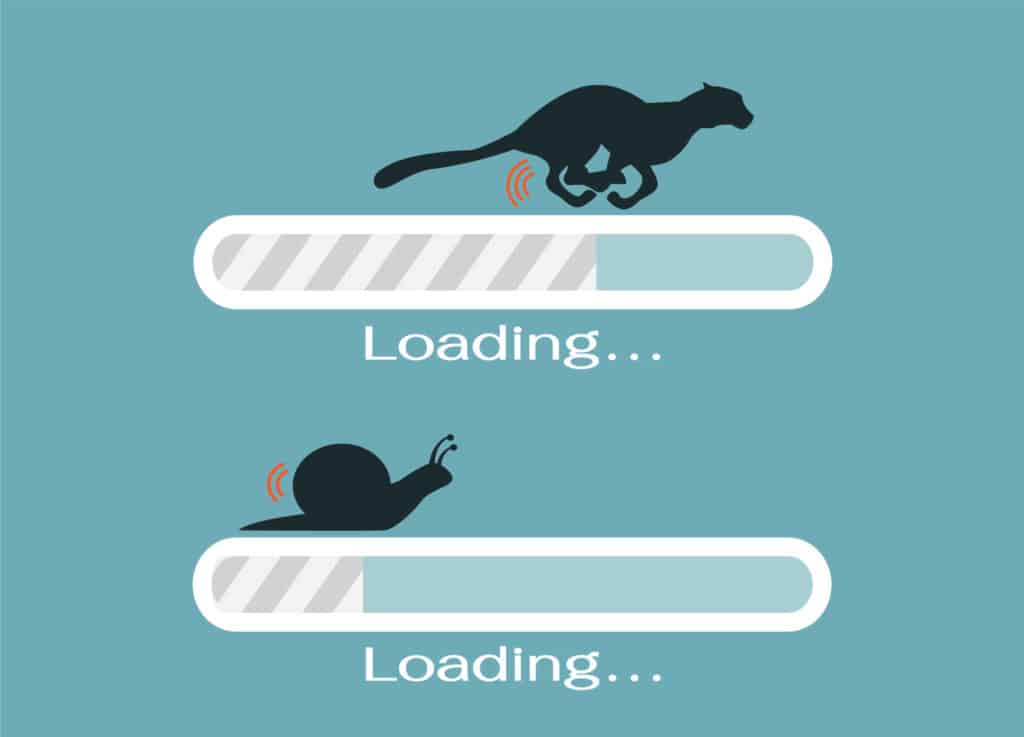There’s been a development in SEO. Meet the all-conquering (and feared) Google Core Web Vitals! *Maniacal Laugh*
Welcome to the world of SEO updates. It can be a scary, relentless quagmire of anagrams, algorithms, terminology, and tech-talk. Unless you think in binary, worship the first-generation Apple Mac, or find the Linux Penguin (Tux) strangely attractive, then it can be somewhat overwhelming.
At DRPT, we like to break all this down into bite size chunks for transparency with our clients. Want to know why we design our websites, or develop the SEO process in the way that we do? Then it’s time we talked about Google’s Core Web Vitals.
What Are These Core Web Vitals You Speak Of?
To us techy geeks, the term Core Web Vitals is pretty self explanatory. Yet, to those in other worldly realms, the terminology probably holds little-to-no meaning. Kinda like how James Corden’s opinion remains incoherent to anyone but himself.
So, what are core web vitals? Why are they so important for modern-day businesses? And why is James Corden so hateful? Let’s delve in for the answers.
In a nutshell, Core Web Vitals (CWV) outline the specific set of factors that Google considers imperative to the user experience on each webpage.
Introduced as a new metric by Google to counteract a lack of representation for user experience in the SEO algorithms, the importance of Core Web Vitals is due to become evermore dominant as the years press on.
Got that? Hopefully you have, as here comes the next part – LCP, FID, and CLS. Contrary to what you may believe, these acronyms don’t represent hard illegal substances. Wishful thinking, for having made it this far into the article, perhaps.
Instead, these acronyms represent the three specific measurements that relate to page speed and user interaction. Combining the three channels creates a triple filter that Google utilizes for sizing up each webpage’s overall user experience.
If you don’t measure up in the Core Web Vitals sweepstakes, you can watch the SEO rankings descend month-on-month akin to James Corden’s approval ratings. Yes, I went there. Get over it.
Largest Contentful Paint (LCP)
Largest Contentful Paint (LCP) may sound like a moderately-powerful Pokémon, but it actually refers to the length of time taken for a page to load; from the point of view of actual users.
If your webpage takes an excessive length of time to load the majority of on-screen content upon clicking the page link, then you’ve failed the LCP test.
Don’t panic, however. Google doesn’t keep a tank of enraged piranhas awaiting you for such failure (that we know of), but you will lose out on clients and Return on Investment (ROI) if your website isn’t up to scratch. To some CEOs, the piranha option is preferable to a loss of revenue.
How does LCP differ from other pagespeed measurements? Well, most other page metrics don’t represent what it’s like for a webpage visitor to open their digital destination.
Time To First Byte (TTFB) and First Contextual Paint (FCP) don’t necessarily focus on what really matters when it boils down to load times: being able to interact with the fundamentals of a webpage. LCP, on the other hand, certainly does.
A healthy result can be attained by proving to Google that 75% of your website’s content can load in less that 2.5 seconds. You will automatically gain the wrong kind of attention from Google if a page takes any longer than 4 seconds to load. The kind of attention that could land you in SEO Gulag.
First Input Delay (FID)
The next in Google’s Core Web Vitals revolves around user interaction. First Input Delay (FID) measures the time it takes for a user to actually interact with your webpage.
Interactions can include clicking on a breadcrumb link within the site’s navigation, entering an email address into a lead magnet form, choosing an option from a dropdown menu, or opening up accordion text (also known as collapsable text) on a mobile device.
First Input Delay is held in high regard by the overlords at Google, as FID takes into account how real-world users interact with websites. Except, FID is perhaps less forgiving than most other tyrants.
FID will penalise if the pages take too long before something happens. Should your website not hit the specific criteria for what constitutes an acceptable First Input Delay, not only will the Google bots mock you relentlessly, but your SEO rankings will be affected.
What about blog posts and pages made from content only? For these pages, FID isn’t too big a deal. The main interaction on pages such as these involves scrolling down the page. Some website developers claim that FID isn’t even reported for sites without log-in pages or lead magnets.
However, for most healthcare websites, FID cannot be understated. Pick a fight with the FID algorithms and we can promise that you will suffer. Just like James Corden’s continued presence makes us suffer.
What is a good FID score? Anything less than 100 milliseconds is key here. If you are exceeding this limit, you could have server problems.
Cumulative Layout Shift (CLS)

For those who don’t speak code, should the elements of your page move as the page loads then you’ve got a high CLS.
For example, how often have you been engrossed in a news story and (without warning) the paragraphs jump down a few blocks to make way for an advert? You’ve been the victim of CLS (no compensation companies exist for this. Sorry). And CLS can be a total thug on mobile webpages if development hasn’t worked properly.
To maintain a healthy CLS score, you really want your webpage to be stable as it loads. By following this protocol, webpage visitors don’t have to re-learn where images, links, and call-to-actions are located.
By opting for a solid CLS getup, the webpage also prevents users from clicking on something by mistake. Although this is no excuse when your purchase history is accidentally revealed. You may have to find another explanation for all that Harry Potter merchandise.
CLS is rated on a scale of zero to 1. Zero indicates no shifting elements, whereas 1 certifies that you need to sort things out. A score of less than 0.1 is what to aim for.
Why Core Web Vitals Are Important
Now Google has confirmed that Core Web Vitals has been absorbed into the ranking signals, it demonstrates a shift in how search engine rankings work.
User experience now plays a tangible role in determining which sites sit atop the Search Engine Result Pages (SERP).
All of those websites boasting pre-millennium levels of usability can no longer use digital heritage as the sole bargaining chip against SEO.
A poorly designed – or outdated – website stripped of focus (and bearing the same user experience as a gasoline-filled fire extinguisher) no longer holds place in a contemporary digital world.
Instead, by adhering to the Core Web Vitals, you can work with Google in their aim to bring trustworthy results to each and every search query. You will be rewarded – perhaps with land and a title of gentry – when Google takes over the world.
The introduction of Core Web Vitals came about from Google’s mission to help website architects (and owners) craft pages with user experience purposefully in mind. The days of mindless content and clunky digital experiences (we’re looking at you, Britbox) are over.
Does My Website Have To Change With This Update?
That very much depends on the condition of your website. In regards to content, if you’ve had written content from a professional writer, or the content has already gained authority, then you should not disregard the content of your website.
Google has stated:
“A good page experience doesn’t override having great, relevant content. However, in cases where there are multiple pages that have similar content, page experience becomes much more important for visibility in Search.”
Instead, you should seek to optimize page experience. Want to know how to do that? Get in touch with us. We’d be delighted to help!
On the other hand, if your website layout goes against LCP, FID and CLS, then a complete rebuild is most likely on the cards. When looking to have your website overhauled, don’t be shy to get in touch with us. We can help you there, too!
Please bear in mind that addressing the three acronymed horsemen of Google-apocalypse may require advanced knowledge of web development and coding. Wading into your website’s foundations like Rambo may cause more problems that it solves.
Rest assured that anyone out there with a DRPT-built website already has Core Web Vitals at the heart of their custom-built Physical Therapy website. You can thank us with a 5-star review. Should you feel so inclined (do it. Or the puppy gets it**).
**A treat. What did you think I meant? Shame on you.
Where Can I Find My Core Web Vital Results?
Want to know how your website is performing? To check your basic* Google Core Web Vitals, simply enter the portal in your Google Search Console account.
You can also gauge performance in relation CVW through PageSpeed Insights, Lighthouse, Chrome DevTools, Chrome UX report, and the (aptly-named) Web Vitals Extension.
*Basic, you say? Yes. But we haven’t hidden any information from you. Put simply, these are the cornerstones of SEO’s future. You can expect regular additions to this roster as time moves forward.
Who Can Help Me With Core Web Vitals?
We can! Get in touch with us through our contact page. If you have questions on Core Web Vitals, or simply want to know what our beef is with James Corden, then reach out and we’ll get back to you ASAP!















